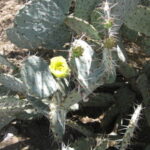Purple Prickly Pear Cactus, (Opuntia violaceae var. santa rita) is a worthwhile addition to the desert landscape. Unlike many of the other species of Prickly Pear, they have a beautiful blue-gray color with shades of purple, which make them so striking in the landscape.
Purple Prickly Pear are native to the Southwest regions of North America. They can grow as large as 6 ft. x 6 ft., but can be pruned to maintain a smaller size. Their pads and fruit are edible, Cold temperature and drought intensify the purple color. They are hardy to approximately 15 degrees F. Vibrant yellow flowers are produced in the spring, followed by red fruit in the summer months. Javelina, rabbits and pack rats will eat the pads. Pack rats will also use the pads to make their homes.
The pads of the Prickly Pear are covered with clusters of 2″ spines as well as tiny spines known as glochids. Glochids are extremely irritating to the skin and detach from the pad very easily. Their tips have a tiny barb, which makes them difficult to remove from your skin. If you need to handle them, use a few layers of newspaper or a piece of carpet. Do not make the mistake of touching the pads with gloves because the glochids will attach to your gloves and render them useless – many gardeners have ruined gloves this way. For those unlucky enough to have glochids embedded in their skin; there are different ways to remove these small spines. One popular method is applying Elmer’s glue and letting it dry and then pulling them off with they glue. However, many people have reported greater success just by using duct tape.
USES: In addition to serving as an accent plant in the landscape, they are also useful as a screen, or as a deterrent to burglars if placed underneath a window. Some people may be surprised to learn that they also make excellent container plants – just make sure they are not near any foot traffic areas. They do well in full sun or light shade in well-drained soil.
MAINTENANCE: Prickly Pears are very low-maintenance plants and can be pruned. Use tongs to pick up the pads or you can use newspaper. Although, extremely drought-tolerant, periodic irrigation during the hot summer months will be appreciated and will improve the appearance of your Prickly Pear. Shriveled pads indicate acute drought-stress.
Many people believe that the appearance of white, cotton-like areas on the pads is a sign of a fungal infection. However, it is actually caused by a small insect that secretes the white cottony mass, called cochineal scale. Control is very easy. Spray off with a strong jet of water from the hose – that’s it!
PROPAGATION: Prickly Pear can be planted from seed, but there is a much easier way. Simply cut off a pad, from an existing plant, that is at least 6 inches tall. Put the pad upright, in a shady, dry place for at least about 2 weeks. This allows a callus to form at the bottom. After two weeks and the callus has formed, plant with the cut end down. Do not water for the first month because the bottom is susceptible to fungal infections. After the first month, water every 2 – 3 weeks until established. If planted in the summer, provide shade until established (about 3 months). Although Prickly Pear can be planted any time of year, it is better to wait until spring when the soil warms up.
HELPFUL TIP: If you have an overgrown Prickly Pear, you can prune it, or you can start over by taking it out and cutting off some of the pads and plant them in the same place.
INTERESTING HISTORICAL FACT: The Aztecs cultivated Prickly Pear cactus infected with cochineal scale because the insects secrete a dark red dye with crushed. This was used to dye cloth. The Spanish exported this dye from Mexico back to Europe where it was used to dye royal garments and British military uniforms. The dye was highly valued by the Spanish, next to gold and silver. It takes 70,000 insects to produce 1 pound of dye.
The Purple Prickly Pear is a beautiful cactus that is an asset to the desert landscape. It’s many attributes include that fact that it is low-maintenance, easy to propagate and has historical value. So, plant one today.




